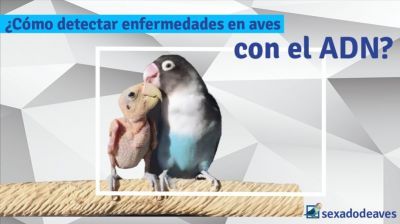Detection Of Bird Disease With Dna Test, How Does It Work?
Life is a constant struggle for existence. This is what animal documentaries show us on TV in the afternoon. However, there are also other fights as important as much smaller scale than in the African

Life is a  constant struggle for existence. This is what animal documentaries show us on TV in the afternoon. However, there are also other fights as important as much smaller scale than in the African savannahs. I am talking about battles that the cells have to fight against each other. Our pets have organisms, in which each cell takes part in epic and intense battles. In order to have healthy pets, we should anticipate all infections caused by microorganisms, which could be done through vaccines and anitbiotics, but there is still a long way to go before we can immunize ourselves against the wide variety of pathogens waiting for the best time to be able to “use” organisms at their convenience. So far, for our petbirds, we can only base our defense strategy on prevention and early detection of diseases. In this post, I try to present you the analysis process carried out by a molecular biology laboratory to diagnose the presence (or not) of the PBFD virus (Psittacine Beak and Feather Desease also called Beak and Feather Virus).
constant struggle for existence. This is what animal documentaries show us on TV in the afternoon. However, there are also other fights as important as much smaller scale than in the African savannahs. I am talking about battles that the cells have to fight against each other. Our pets have organisms, in which each cell takes part in epic and intense battles. In order to have healthy pets, we should anticipate all infections caused by microorganisms, which could be done through vaccines and anitbiotics, but there is still a long way to go before we can immunize ourselves against the wide variety of pathogens waiting for the best time to be able to “use” organisms at their convenience. So far, for our petbirds, we can only base our defense strategy on prevention and early detection of diseases. In this post, I try to present you the analysis process carried out by a molecular biology laboratory to diagnose the presence (or not) of the PBFD virus (Psittacine Beak and Feather Desease also called Beak and Feather Virus).
Battles of Life
Imagine a fortified city. The stone walls delimit its perimeter and protect it against any attack. The villagers want to stay safe. The attackers  seek to enter and seize all that is inside the city. Each cell of our parakeets is similar to a fortified city and the avian circovirus (PBFD virus) tries to enter to take control of its resources. The circovirus is a small strand of wrapped DNA waiting for its moment to use the cellular machinery. It is an intracellular parasite, which, once inside the body, inserts its DNA and takes control of all the cellular resources that will then put at its service to dedicate itself exclusively to its reproduction. We can say that the virus is also an organism that fights for its survival.
seek to enter and seize all that is inside the city. Each cell of our parakeets is similar to a fortified city and the avian circovirus (PBFD virus) tries to enter to take control of its resources. The circovirus is a small strand of wrapped DNA waiting for its moment to use the cellular machinery. It is an intracellular parasite, which, once inside the body, inserts its DNA and takes control of all the cellular resources that will then put at its service to dedicate itself exclusively to its reproduction. We can say that the virus is also an organism that fights for its survival.
In search of lost DNA (in the blood!)
Circoviruses do not attack any cell. They infect the growth cells of the follicles of the feathers, beaks and claws of birds. Does this mean that we can only know if there is a PBFD virus from samples of these tissues? We explained at the beginning, the importance of doing prevention or, failing that, to identify an infection in time. Veterinarians, breeders, and pet owners strive to diagnose the disease as quickly as possible before the virus spreads. Viruses, like many pathogens, use the bloodstream to reach the other cells of the infected organism. Genetic techniques now allow us to identify these infectious “sentinels” that roam the body of their host to find new “citadels”. To a certain extent, the lab technicians are similar to policemen who seek to capture the pathogen. A virus circulating freely in the blood is surrounded by thousands of host cells. When one seeks to identify a disease by genetic techniques, it is a question of finding among thousands of copies of the same DNA of the host, a single copy of the DNA of the pathogen. However, the laboratory’s “road policeman” have an ace up their sleeve, called PCR: the Polymerase Chain Reaction (PCR), also used for the molecular sexing test. This technique makes it possible to obtain millions of copies of any fragment of the circovirus DNA needed to differentiate it from the genetic material of the host. In this way, we can increase the proportion of the pathogen’s DNA in our tests and almost eliminate the proportion of the animal’s DNA tested.
 Once the PCR is performed, millions of copies of DNA are obtained in a single tube, dissolved in a generally transparent liquid. How do we know if these copies come from the circovirus and, therefore, if the diagnosis is correct? Laboratory technicians determine the genome sequence they want to use to copy the DNA.
Once the PCR is performed, millions of copies of DNA are obtained in a single tube, dissolved in a generally transparent liquid. How do we know if these copies come from the circovirus and, therefore, if the diagnosis is correct? Laboratory technicians determine the genome sequence they want to use to copy the DNA.
DNA is made up of smaller units called “nucleic bases or nitrogen bases” that combine with each other, forming a kind of rosary, which determines the length (dimension) of the amplified fragments.
For the diagnostic test of PBFD, the laboratory does not study the composition of the fragments but checks whether the obtained length matches (or not) with the expected dimensions. The fragments are obtained after having submitted the mixture resulting from the PCR, to an electric field and compared them with standard control fragments, after having introduced them and let them grow in an agarose gel (in solid medium) in order to be able to compare their sizes. If the number of nucleic bases of this “rosary” corresponds to the one that we amplified, we will be able to confirm that the analyzed sample is infected with PBFD virus.
It is important to remind that not all the pathogens go through the bloodstream. Blood is not always the most appropriate sample for molecular testing. For this reason, clinical analysis laboratories may sometimes ask for tissue or swab samples (cloacal or oral) instead of blood, depending on the disease to be analyzed. Regardless of the type of sample to send, do not worry: lab technicians will act as guardians of your animals and look for pathogens to improve the health of your birds
Dr. Alejandro Centeno-Cuadros
(Responsable scientifique du Laboratoire – Département Aviaire)

